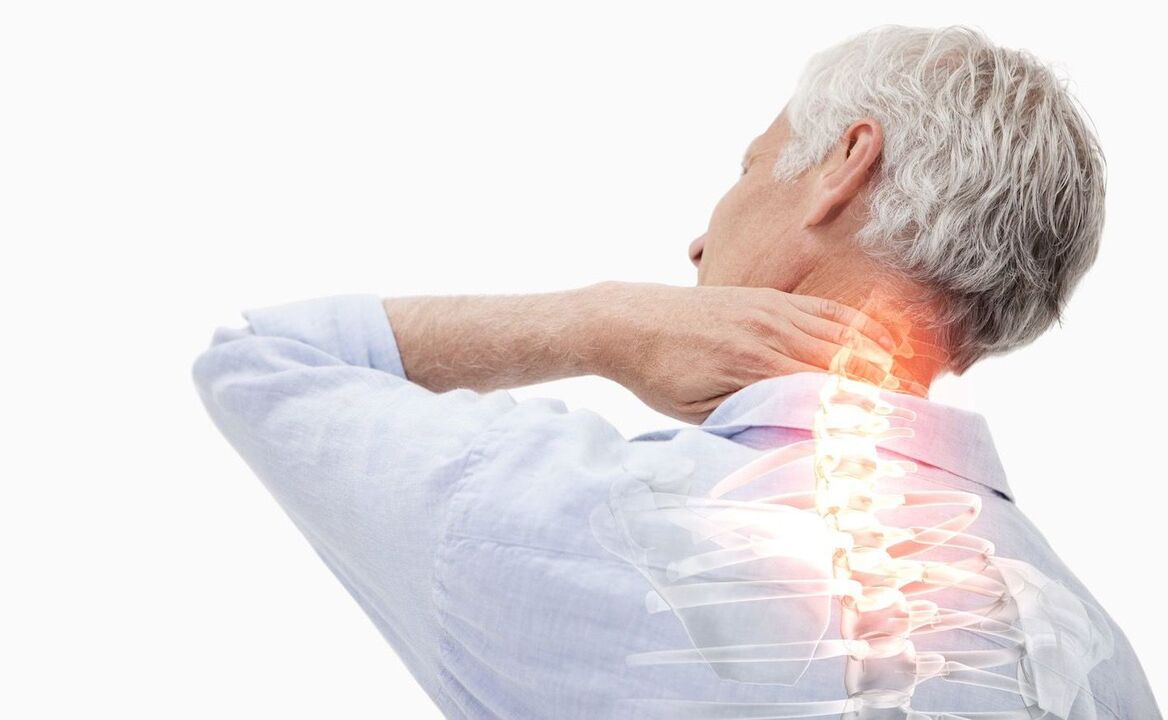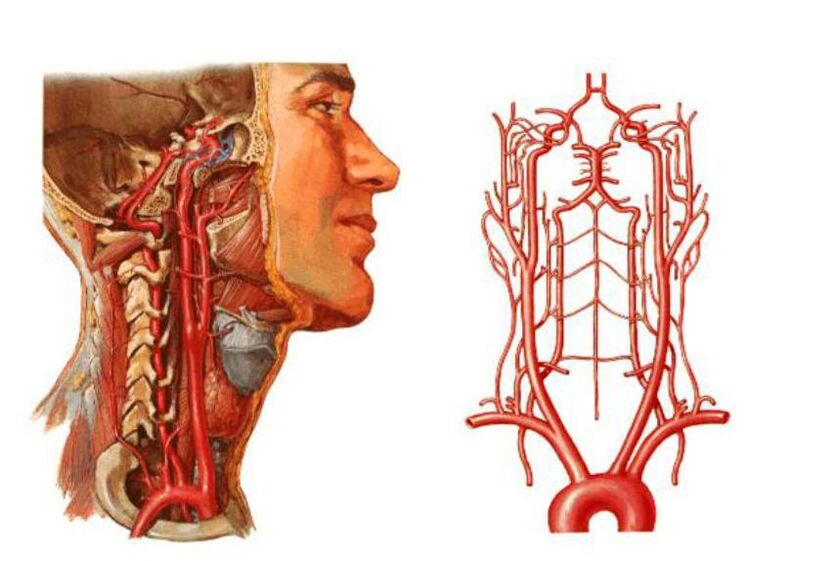Among all the pathological processes that affect the spine in its different parts, cervical spondylosis is considered one of the most common. This disease causes a lot of complications, mainly because it affects the spinal cord and also negatively affects the functioning of the brain.
According to 2017 statistics, the disease has become significantly younger. If previously osteoarthritis mainly affected people after 40 years of age, today various stages of cervical osteoarthritis are diagnosed in 90% of people over 25 years old. For this reason, it is important to know as much as possible about the condition, from what it is to its treatment.

What is degenerative neck vertebrae?
In medical practice, the word cervical spondylosis means an acquired progressive disease that affects a specific part of the spine. This pathological process is characterized by degenerative-dystrophic processes in the tissues of the intervertebral disc, which are shock absorbers for the cervical vertebrae.
Degenerative-dystrophic changes in the intervertebral discs are caused by their wear and deformation. As a result, the distance between the vertebrae is reduced and leads to the following consequences:

- Narrowing of the spinal canal in certain areas of the spine.
- Compression of the vertebral artery - a large blood vessel that supplies blood to the brain. Because of this, the supply to the brain is impaired and blood circulation in the cervical spinal cord is disrupted.
- The disc can become deformed and flattened. This leads to compression in certain areas of the spinal cord and nerves, often nerve root compression occurs.
All these problems threaten not only impaired blood circulation in the brain, neck pain, headaches, etc. v. The development of cervical spondylosis is also dangerous with neurological problems, central nervous system deterioration and brain tissue damage.
According to the international classification of diseases, cervical spondylosis is assigned a separate code number. Disease codes according to ICD 10 depend on the age at diagnosis:
- M02 – juvenile disc dystrophy.
- M42. 12 – Degenerative process of the neck in adults.
A lot of factors depend on the patient's age and the degree of development of the pathological process, such as consequences, complications, symptoms and, of course, the principles of treatment.
reason
Knowledge of the causes of the development of cervical spondylosis can play a decisive role in the diagnostic process as well as in determining the principles of combating this disease.
However, before listing the causes, it is worth saying that doctors identify two factors that lead to the development of this pathological process:
- Pathology - destruction of intervertebral discs and other vertebral structures with the involvement of neighboring tissues, vessels and nerve bundles in the pathological process that occurs under the influence of adverse external factors. The more serious these factors and other pathologies are, the faster the disease develops.
- Physiological – the development of pathology is mainly based on age-related changes. We are talking about the natural aging of cartilage tissue in the spine, salt deposits, etc. v.
If we list more specific causes of cervical spondylosis, they are as follows:
- Disturbances in metabolic processes in the body, as well as some stages of obesity.
- Physical inactivity is a phenomenon characterized by limited mobility. We're not just talking about injury or illness, this also includes a sedentary lifestyle and sedentary work.
- Pathologies of the cardiovascular system contribute to impaired blood circulation in the brain, changes in pressure, etc. v.
- Poor posture includes many forms of scoliosis, rheumatism and even flat feet.
- Cervical spine injury. In this case we are talking about sprains, beatings, bruises. Injuries to other parts of the spine can influence the development of cervical spondylosis.
- Excessive physical stress on the cervical spine, either from intense sports or severe physical difficulty, depends on the type of activity each person has.
- A sedentary lifestyle is also dangerous because the cervical spine and the entire spine are constantly strained if you sit incorrectly or sit on uncomfortable furniture.
- Cervical spondylosis, as well as various accompanying diseases.
- Being forced to hold the head for long periods of time in an uncomfortable or unnatural position. In this case, not only muscle tension occurs, but the spine in the cervical region also curves.
- Doctors consider constant stress and nervous tension to be very common causes.
- One of the causes is also believed to be due to congenital defects in the spinal structure.

What health risks does it pose?
As mentioned earlier, the cervical spine region contains not only the spinal cord and various nerve branches, but also the vertebral arteries that supply blood to the occipital part of the brain, the cerebellum, and the medulla oblongata.
With the development of cervical spondylosis, neighboring tissues become inflamed. In addition, as the disease develops, there is a risk of nerve root compression and blood vessel compression, with the following consequences:
- Osteonecrosis is accompanied by spinal deformity, leading to spinal stenosis in some areas. This can lead to compression of the spinal cord and nerve branches, causing serious neurological problems. In severe cases, a person feels pain and is even likely to lose control over certain parts of the body (mainly the arms or face).
- Compression of the vessels in the neck, as already mentioned, is accompanied by impaired circulation in the occipital region of the brain. In this case, the brain stops receiving oxygen and nutrients in the necessary quantities and hypoxia begins. If blood circulation is impaired, there is a real risk of ischemic stroke and various neurological pathologies.
syndrome
Talking about the danger that cervical spondylosis causes when it progresses and is not treated appropriately, this disease can lead to a number of complications and syndromes.
The main syndromes are:
- Vertebrae.
- Spinal artery.
- Koreshkovy.
- Heart.
It is important to know that each of these symptoms is accompanied by painful sensations of a different nature, as well as a variety of adverse clinical signs. A person may feel dizziness, ringing in the ears, etc. v.
Vertebral syndrome
Talk about a direct connection between cervical cartilage degeneration and bone and cartilage tissues. Symptoms of this type of pathology are also associated with damage to the mentioned tissues:
- Neck movement is partially or completely limited.
- Movement of the head is accompanied by pain in the neck area.
- X-rays show morphological changes in the tissues (vertebral bodies and vertebrae).
It is worth noting that vertebral syndrome is always accompanied by these 3 clinical signs. If at least one of them is missing, the diagnosis will be completely different.

Vertebral artery syndrome
This syndrome occurs due to narrowing of the vertebral artery, leading to problems with the vestibule, blood vessels, and autonomic nervous system. In this case, the main symptoms are diverse:
- Headaches and migraines.
- Blind.
- Noise in the ears.
- Frequent dizziness and more.
The most dangerous symptom is fainting, indicating severe lack of oxygen.
Nerve root syndrome
Occurs when the spinal cord roots are damaged. In this case, nerve transmission is interrupted, the patient may feel pain or loss of sensitivity in some parts of the body, or even become paralyzed.
Depending on which of the 8 root pairs the conduction disorder occurs, the following symptoms are determined:
- 1 pair – numbness or pain in the back of the head;
- 3rd pair – impaired chewing reflex, numbness of the tongue and discomfort behind the ears;
- 4 pairs – pain in the clavicle area, impaired swallowing reflex;
- 5 pairs – shoulder girdle disorders, accompanied by problems with arm movement;
- 6th pair - the patient begins to feel pain and numbness in the forearm and shoulder blades;
- 7th pair – the hand and fingers (usually the index and middle fingers) are numb;
- 8th pair – same problem as the previous point, but there is numbness in the ring finger and little finger.
Based on the described characteristics, it is sometimes possible to determine which pair of roots is affected by root syndrome.
Heart syndrome
Although the pathological process remains localized to the cervical spine, this syndrome has all the signs of cardiovascular disease. The clinical picture is as follows:
- Rapid pulse.
- Pain in the sternum.
- Shortness of breath, weakness, lethargy, decreased performance.
Degree of disease development
When talking about the degree of cervical spondylosis, we mean the progressive stages of the pathological process, which differ in clinical signs. In total, there are four degrees of disease development:
- The first stage is characterized by vague symptoms. The patient complained of mild headaches; during the initial examination, the doctor noted a mild degree of muscle stiffness.
- Pain in the cervical spine and head is more common, more intense, and radiates to the shoulders and arms. The disease is caused by damaged discs and compressed nerve roots. The pain increases when turning the head, leaning back and bending forward.
- In the third stage, there is constant pain, muscle weakness in the arms and herniation in the intervertebral discs. Movements in the neck area are limited and dizziness often occurs.
- The fourth stage is accompanied by complete destruction of the intervertebral disc, cartilage tissue is replaced by connective tissue. In addition to pain and dizziness, there are also problems with coordination and the vertebral arteries are often compressed.
Signs and symptoms of cervical spondylosis
To consult a doctor promptly, you need to clearly understand the signs of cervical spondylosis. In some cases, such knowledge allows you to seek help in the early stages of the disease, when treatment is easier.
In general, symptoms of cervical spondylosis are as follows:
- The pain from osteoarthritis is always present, just with different intensity and frequency. Pain is the first clinical sign. Their intensity depends on the stage of disease progression; they have a smoldering or repressed quality. The pain mainly appears in the neck and occipital areas, but can also spread to the temples, lumbar shoulders and arms.
- In most cases, there is evidence of damage to the vestibular apparatus. We are talking about frequent dizziness, nausea, poor coordination of movements, irregular gait, loss of space.
- One of the most common clinical signs is neck muscle stiffness and stiffness during movement. It is difficult for a person to turn his head, lower it and tilt his head back, movements are accompanied by pain.
- Many patients report a "goosebumps" sensation running across the scalp or a characteristic tingling sensation.
- Muscle weakness and numbness occur in the arm area.
- There are often psychological manifestations, manifested in depression, drowsiness, sudden mood changes, impatience or irritability.
- Due to poor circulation and damage to brain tissue, dizziness increases and noise in the ears similar to rustling, pulsing and ringing appears.
- Most patients note deterioration of vision, as well as pain in the eyeballs, especially when trying to squint too much left, right, up or down.
Sometimes it is possible to determine the degree of development of the pathological process by symptoms. However, for a complete diagnosis this is not enough and several diagnostic measures are required.

Diagnostic method
Diagnosis of cervical spondylosis is necessary to determine the location and stage of progression of the disease. For a complete diagnosis, the following diagnostic methods are required:
- X-rays are the main method to determine the degree and location of spinal deformity.
- Computed tomography can be used to more accurately diagnose pathological changes in the vertebrae and intervertebral discs.
- MRI (magnetic resonance imaging) - allows detailed examination of intervertebral discs and vertebrae, determining the presence of hernias, protrusions, degree of damage, etc. v.
- Dopplerography - with this examination it is possible to find the site of compression of the artery and assess the degree of circulatory disorders.
Treatments
Treatment of cervical osteochondrosis always includes a comprehensive approach. The principles of treatment depend on many factors, such as the patient's age, the stage of disease development, the severity of the clinical picture, etc. v. .
However, you cannot do without a doctor in this situation and you can first contact your general practitioner, who will then refer you to a vertebra specialist.
As for the integrated approach: cervical spondylosis is treated with pharmacotherapy, physiotherapy, massage, therapeutic exercise and other methods, which are worth talking about in more detail.
Treatment medicine
The basis for the treatment of cervical spondylosis is drug therapy, which includes the use of tablets, pills and drugs of the following groups:

- Analgesics - pain relievers and antispasmodics. The first substances directly paralyze the nerve centers, thereby reducing the feeling of pain. The latter allows you to relieve neck muscle spasms, improve blood flow and relieve pain.
- NSAIDs - non-steroidal anti-inflammatory drugs are needed to reduce inflammation, most of them also help eliminate pain. Usually these medications are used in gel or ointment form to rub into the affected area.
- Muscle relaxants are another way to reduce muscle spasms in the cervical area.
- Chondroprotectors are required at certain stages of spinal osteoarthritis, as they contribute to the recovery of bone tissue.
- Vitamin B - normalizes the metabolism of nervous tissue, improves the conductivity of nerve impulses and promotes the functioning of the central nervous system.
Remember, treatment should be carried out only under the supervision of a doctor, who is responsible for prescribing each drug, as well as determining the duration of use and dosage.
Physical therapy
Treatment of cervical osteoarthritis will be many times more effective when using some physical therapy techniques:
- Electrophoresis.
- Laser therapy.
- Supersonic.
- Massage.
Massage therapy must be performed by an experienced medical professional, the treatment is carried out over a course of at least 10 sessions. Cervical massage helps normalize blood circulation, restore elasticity, muscle tone, relieve pain, etc. v.
Physical therapy
Therapeutic exercises also help speed up recovery but should only be performed during the recovery phase. It is important that the exercises do not cause discomfort or pain to the patient. Exercise therapy aims to strengthen muscles and reduce movement discomfort by increasing the elasticity of muscle fibers.
The initial exercise technique is developed by a physiotherapist, after which the patient can independently perform exercise exercises at home.
Manual therapy
Manual therapy is based on the principle of restoring motor function and mobility between vertebrae. Initially, the manipulations include a light relaxing massage, then the doctor applies more and more force, applying pressure and rotating the neck to the vertebrae.
Kuznetsov applicator
The use of the Kuznetsov applicator is one of the methods of treating diseases of the spine, including osteoarthritis. The effect of the device on the cervical spine helps normalize metabolism, relieve pain, increase muscle tone, improve blood circulation, increase the conductivity of nerve tissue, etc. v.
Treatment at home
All treatments are performed at home, with the exception of physical therapy, massage (in some cases) and the initial phase of exercise therapy. However, now we are talking about traditional medicine and we will consider some of the most effective recipes:
- To use horseradish - take a leaf of this plant, pour boiling water over it and apply the inside to the neck, wrap it with a bandage. Can be left on while you sleep to enhance effectiveness.
- If there are no contraindications from your doctor, heating the cervical spine will be a good treatment method. The simplest method is to use pepper putty, but you can heat the wax cake, apply it 1-2 times until it cools completely.
Disease prevention
To prevent the development of the disease or recurrence after treatment, it is necessary to prevent cervical spondylosis. It includes the following simple recommendations:
- Sleeping on a flat, hard surface, it is better to purchase a special orthopedic mattress and a pillow shaped like your head.
- To prevent the disease, monitor your physical activity and do not overexert the spine. If you must lift weights, do so gently and keep your back straight.
- If your job requires you to sit for long periods of time, take a break. Every hour you need to walk or stretch stiff muscles with simple exercises.
To prevent osteoarthritis, you should swim and hang on a horizontal bar for 2-3 minutes every day.
























